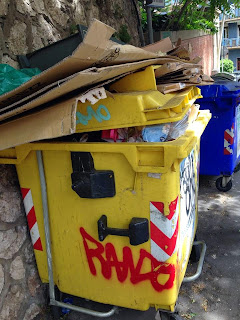This past weekend we were fortunate enough to have another weekend trip Friday and Saturday. We took a road trip to about 2.5 hours away to Nuoro, Orgosolo, and Orosei. We first visited an anthropologie museum and got to learn a bit about the local way of life in this region. Pictured below are some of the traditional dresses which are still worn during festival times. The bells on black figurines weigh about 40 lbs! The area had many bandits in the past, well into the 70s. They target the rich and famous, but luckily I am none of those (though I secretly wanted to see one roaming around).
Then we briefly visited a church which had the tombstone of a famous writer Grazia Deledda of Sardinia. She wrote about the life on the island and started writing as a teenager. Her talent won her the nobel prize-I hope to read her translated work someday!
Next we drove over to Orgosolo where we dined with the shepards. Pictured below was some of the food we ate. We had pork, lamb, potatoes, bread, cheese, and wine. A common theme of Sardinia, the food was simple yet amazing since they are made with the freshest ingredients. Afterwards, as pictured, we watched the shepards sing and dance the food away.
Next, we went to the town's main square and saw the beautiful street art all over the town. It was cool to see all the different kinds of messages posted on the walls. Many of them were political, as the one pictured below, however some of them were simply drawings as well. I wish there were more of these forms of free art around Boston and the U.S. in general.
Next, we went to the hotel where we stayed the night and ate some more delicious food (including rabbit!). It was my first time having rabbit and though I enjoyed it, I loved the lamb we ate more. I am going to be very disappointed going home and not eating a ten course meal every day. Pictured below is the beautful sunset that accompanied the stay.
The next morning we got up bright and early to hop on to a mini cruise starting about an hour away. The first stop was at a cave, which extended for 20 km! We were allowed to see 4 of the main "halls" of the cave. My favorite one was the mirrors "hall", in which the water seemed to reflect the cave almost perfectly. Though the insides were breath-taking to saw the least, no photography was allowed inside the cave so I was forced to take mental pictures in my head. But, I feel lucky to have had the opportunity to see it since the cave is only viewable April-October since otherwise the water fills the depths of the caves. Pictured below is the view from the cave looking out.
The next two stops were two beaches along the coast. The water was absolutely clear and goregeous. The water was so clear that you could see the fish and pebbles at the very bottom. The water was very salty as expected and slightly cold, but not remotely close to the freezing temperature of the Atlantic. It was a relaxing day and I was hoping the boat would forget to pick us up, but unfortunately, it did not. Pictured below is an attempt to capture the beautfy of one of the beaches.
The next day was a free day in Cagliari, so I decided to roam around and look at all the sites Cagliari has to offer. We first went to the national archeology museum, which was filled with many artifacts from the nuraghic, punic, and phonetian ages. It was cool to see how the generations differed from each other and to see how the archeologists found some of these artifacts and how they deduced information about the different time periods. Pictured below are some of the excavated items found.
Then, we proceeded to several places. Firstly, we went to the pinocoteca national art museum which featured 16-18th century art. Next we went around the square near by and found a tower and saw the amazing view from the top. Then we continued on roaming and stumbled upon the king's palace, which was so intricately designed, with pretty chandeliers and ornate wall hangings. We ended the excursions back at our favorite and underappreciated food place, the zaza kebab place. Pictued below is some of the excursion sights.
Overall an enjoyable weekend! Rebecca Black is right-"eveybody's looking forward to the weekend".

















































